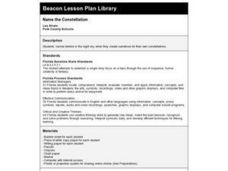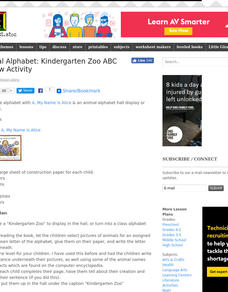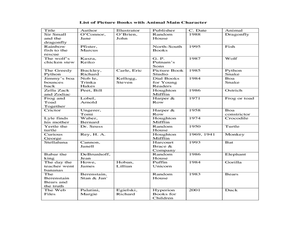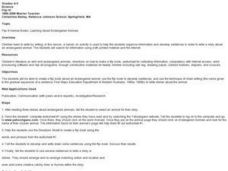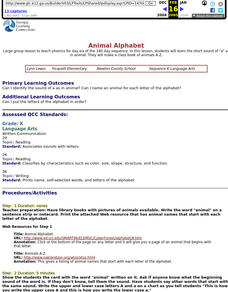SeaWorld
Animal Migrations
Here is a fabulous set of activities for your young scientists. Each lesson contains map, hands-on, and game activities that will help the class understand why and how animals migrate from one place to another. First they'll examine the...
Curated OER
Animal Alphabet
Review the alphabet and the sounds each letter makes before having learners identify animals whose names begin with each letter. Working in groups of four to six, they make an animal alphabet book with the letter, a picture of the animal...
Curated OER
Animal Signs
Students discuss the many different types of animal signs that can be used to identify and track animals. They participate in an hands-on activity in which they examine tracks, trails, homes, territory markings, and even "scat" left by...
Curated OER
Reading
Primary readers read books in order to practice word recognition, rhyming, and play reading games. They will "read" simple books to reinforce basic reading skills in order to create a foundation. Readers are available to print out along...
Curated OER
Animal Classifications
Third graders work in small groups to investigate how to sort a variety of items into groups and subgroups. They work on a class chart based on the activity which show how the items are classified based on commonalities. Upon completion...
Curated OER
Name the Constellation
Students read stories about constellations. They create constellations by filling in the letters of their names on a test bubble sheet and tracing the design onto white paper. They make up stories about their name constellations.
Curated OER
Animal Alphabet: Kindergarten Zoo
Students explore the letter sounds and read the book, "A, My Name is Alice." They create a page for a class alphabet book or zoo animal display.
Curated OER
Find an Animal! Find a Book!
Learners identify the themes of different books by classifying their genre. In this genre lesson, students examine a specific animal by reading both a nonfiction and fiction book about the species. Learners compare the...
Curated OER
Report on Desert Plant or Animal
Students are introduced to desert plants and animals. They demonstrate that the name of an organism does not always match the object. Students perform a guided internet search in order to complete a report.
Curated OER
Animal Legends
Seventh graders review the concept of a legend. Using the internet, they research animals found in Illinois. They write their own legends based on the animal they researched. They share their story and show pictures of the animals to the...
Curated OER
ABC and 1-2-3 Farming
Students demonstrate how to alphabetize animal names. In this word study lesson, students identify animals that live on the farm and conduct a favorite farm animal survey. Students order animal pictures in alphabetical order.
Curated OER
Regents High School Examination: Living Environment 2003
The living environment, from the interior of a cell to the complex relationships among populations, are queried in this final examination. Learners look at air pollution maps, diagrams of cells, population graphs, and drawing of cells....
Curated OER
Regents High School Exam: Living Environment 2008
Tne New York Regents High School Examinations are comprehensive and include various styles of questions, includingmultiple choice and the analysis of graphs. This particular version, the 2008 Living Environment exam surveys a variety of...
Curated OER
Regents High School Examination: Living Environment 2005
The 2005 version of the Regents High School Examination in the area of ecology is as comprehensive as previous years' exams. It consists of 40 multiple choice questions on everything from the structure of DNA to the interactions within...
Curated OER
Animal Riddles
Students research an animal using online research .They create a multimedia riddle using the information and share it with the class.
Curated OER
Animal Morphs
Learners explore animal drawing. In this cross curriculum drawing, photography, and animals lesson plan, students combine computer drawing and freehand drawing to create an animal and its environment using a photograph of...
Curated OER
Science: Animal Body Parts
Young scholars examine animal vocabulary words and identify which animals have those characteristics. In small groups, they play an animal card game involving more vocabulary words. Students continue to drill on terms by completing...
Curated OER
We're Counting At The Zoo!
Budding mathematicians use sets of concrete materials to represent, count, and match quantities to 10 or more given in verbal or written form while participating in hands-on activities. This instructional activity uses the book 1,...
Curated OER
Flip It!
Young scholars research an endangered animal using both printed material and the Internet. They organize their information and develop sentences to write a story to create a flip-it book. A worksheet is embedded in the lesson for...
Curated OER
Animated Alphabet
Students explore English by completing an interactive language history activity. In this word recognition activity, students discuss word formations and the phonetic relationship between letters. Students identify the origin of...
Curated OER
Animal Alphabet
Students make a class animal book using the letters of the alphabet. They use a website imbedded in this plan to get pages with animals that begin with any of the 26 letters.
Curated OER
Perspectives on Animals
Engage your class in a discussion about humane treatment of animals by recognizing the basic rights of all races, religions, classes, etc. Have volunteers stand on a milk crate without shoes until they become uncomfortable as an example...
Curated OER
Animal Research Project
First graders are introduced to the topic of researching by the librarian. Using a worksheet, they use various sources in the library to choose one animal from various groups. They complete a fact sheet on each animal and report their...
Curated OER
The Loneliest Animals
Students examine the different species that are headed towards extinction. In this animal population lesson plan students compare the causes of extinction, research an endangered species and present an oral report.





